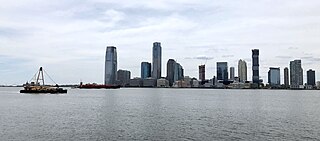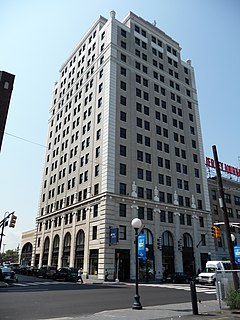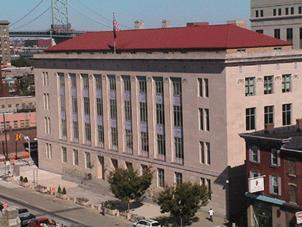
Camden is a city in and the county seat of Camden County, New Jersey, in the United States. Camden is located directly across the Delaware River from Philadelphia, Pennsylvania. At the 2010 U.S. Census, the city had a population of 77,344. Camden is the 12th most populous municipality in New Jersey. The Census Bureau's Population Estimates Program calculated that the city's population was 73,562 in 2019, ranking the city the 487th-most-populous in the country. The city was incorporated on February 13, 1828. Camden has been the county seat of Camden County since the county was formed on March 13, 1844. The city derives its name from Charles Pratt, 1st Earl Camden. Camden is made up of over twenty different neighborhoods.

Jersey City is the second-most populous city in the U.S. state of New Jersey, after Newark. It is the seat of Hudson County as well as the county's largest city. The U.S. Census Bureau's Population Estimates Program calculated that the city's population was 262,075 in 2019, ranking as the 80th-most-populous incorporated place in the nation. The 2019 estimate represents an increase of about 5.8% from the 2010 United States Census, when the city's population was at 247,597, ranking the city the nation's 78th-largest by population.

The Port of New York and New Jersey is the port district of the New York-Newark metropolitan area, encompassing the region within approximately a 25-mile (40 km) radius of the Statue of Liberty National Monument. It includes the system of navigable waterways in the New York–New Jersey Harbor Estuary, which runs along 650 miles (1,050 km) of shoreline in the vicinity of New York City and northeastern New Jersey, as well as the region's airports and supporting rail and roadway distribution networks. Considered one of the largest natural harbors in the world, the port has become the second busiest port by tonnage in the United States as of 2019, and the busiest on the East Coast.

Journal Square is a business district, residential area, and transportation hub in Jersey City, New Jersey, which takes its name from the newspaper Jersey Journal whose headquarters were located there from 1911 to 2013. The "square" itself is at the intersection of Kennedy Boulevard and Bergen Avenue. The broader area extends to and includes Bergen Square, McGinley Square, India Square, the Five Corners and parts of the Marion Section. Many local, state, and federal agencies serving Hudson County maintain offices in the district.

Communipaw is an unincorporated community and neighborhood located within Jersey City in Hudson County, New Jersey, United States. It is located west of Liberty State Park and east of Bergen Hill, and the site of one of the earliest European settlements in North America. It gives its name to the historic avenue which runs from its eastern end near Liberty State Park Station through the neighborhoods of Bergen-Lafayette and the West Side that then becomes the Lincoln Highway. Communipaw Junction, or simply, The Junction, is an intersection where Communipaw, Summit Avenue, Garfield Avenue, and Grand Street meet, and where the toll house for the Bergen Point Plank Road was situated. Communipaw Cove at Upper New York Bay, is part of the 36-acre (150,000 m2) state nature preserve in the park and one of the few remaining tidal salt marshes in the Hudson River estuary.

The Bergen Section of Jersey City, New Jersey is the neighborhood on either side of Kennedy Boulevard between Saint Peter's College/ McGinley Square and Communipaw Avenue in the Bergen-Lafayette section of the city. The name Bergen, used throughout Hudson County, is taken from the original Bergen, New Netherland settlement at Bergen Square.

The Port of Camden is situated on east bank of the Delaware River in Camden and Gloucester City in southern New Jersey in the United States. It is one of several ports in the Delaware Valley metro area port complex and is located near the mouth of Newtown Creek opposite the Port of Philadelphia. The port is one the nation's largest for wood products, steel, cocoa and perishable fruit.

The Camden Free Public Library Main Building is the first former main library of the Camden, New Jersey public library system. Designed by Herbert D. Hale and Henry G. Morse, the building was constructed with a grant from the Carnegie Corporation and opened in 1905. It closed in 1986 with the relocation of the library's main branch to the former South Jersey Gas, Electric and Traction Company Office Building. In 1992, the building was placed on the state and national registers of historic places. The building has fallen into state of serious disrepair. In 2003, funding was found for its stabilization, with the hope that it would be preserved and re-used.

The Camden Waterfront, also known as the Central Waterfront, is a tourist and entertainment district in Camden, New Jersey, on the Delaware River south of the Ben Franklin Bridge and north of Port of Camden.

Cooper-Grant is a neighborhood located in the northwestern part of Camden, New Jersey. According to the 2000 U.S. Census, the neighborhood has a population of 838. The neighborhood is situated near the Ben Franklin Bridge and Rutgers-Camden. It is served by the Cooper Street – Rutgers University River LINE station. The neighborhood is home to the Cooper-Grant Historic District which includes 93 buildings spread over 250 acres. Cooper-Grant is considered one of the city's contemporary residential success stories. It has a relatively low-crime rate and many residents are college-educated professionals and students.

Cooper Point is a neighborhood in the northwestern part of Camden, New Jersey, United States. According to the 2000 U.S. Census, the neighborhood has a population of 2,880. It is north of Cooper Grant and the Central Waterfront the other neighborhoods located near the Ben Franklin Bridge.

Fairview, originally named Yorkship Village, is a neighborhood located in southern Camden, New Jersey. According to the 2000 U.S. Census, Fairview Village has a population of 5,947. Much of the neighborhood is part of a historic district listed on the state and federal registers of historic places.
Parkside is a neighborhood in Camden, New Jersey. Located near the Cooper River, the neighborhood has a population of 4,494. Our Lady of Lourdes Medical Center and Harleigh Cemetery are located in the neighborhood.
Holtec International is a supplier of equipment and systems for the energy industry founded in Mount Laurel, New Jersey and based in Jupiter, Florida, United States. It specializes in the design and manufacture of parts for nuclear reactors. The company sells equipment to manage spent nuclear fuel from nuclear reactors.
The Port of Paulsboro is located on the Delaware River and Mantua Creek in and around Paulsboro, in Gloucester County, New Jersey, United States, approximately 78 miles (126 km) from the Atlantic Ocean. Traditionally one of the nation's busiest for marine transfer operations, notably for crude oil and petroleum products, such as jet fuel and asphalt, it is a port of entry with several facilities within a foreign trade zone.

The South Camden Trust Company building is located within the Waterfront South area of Camden, New Jersey and was listed on the state and federal registers of historic places in 1990. Built in the 1920s, it has long functioned as a church.

The United States Post Office and Courthouse (1932) and the Mitchell H. Cohen United States Courthouse (1994) house the United States District Court for the District of New Jersey in Camden, New Jersey. The back-to-back buildings are joined by a second story enclosed skyway.

The Benjamin Cooper House is an 18th-century farmhouse and ferry house in Camden, New Jersey in the United States located at Erie Street in the Pyne Point neighborhood in North Camden. It was originally built in 1734 and served as ferry stop as well as residence. It later was a hotel and entertainment venue. The building suffered extensive damage in a fire on Thanksgiving Day 2012.

















